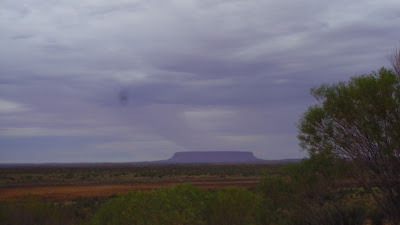In case you're keeping track, I've been to the 6 Australian states: New South Wales, Queensland, South Australia, Tasmania, Victoria, and of course Western Australia. I've also been to the Australian Capital Territory. It was time to tick the last state/territory, the Northern Territory, off my list and head in to the centre, literally.
Flying from Western Austrlia to Alice Springs, you cross some of the barest outback. THere aren't even roads for awhile. Then just a few scattered mines with dirt roads.
Alice Springs in the "center" of the centre, almost halfway between Adelaide and Darwin.
Alice Springs itself isn't much to write home about, but it's surrounded by beautiful ranges.
Before I moved to Australia I read a few novels about the Lucky Coutnry, including Bill Bryson's "In A Sunburned Country" (titled"Down Under" in oz). And I still remember him describing his brief trip to see Uluru.
"So you are aware, as you drive to the park entrance and pay the ambitiously pitched admission fee of $15 a head and follow the approach road around, that you have driven 1,300 miles to look at a large, inert, loaf-shaped object that you have seen photographically portrayed a thousand times already. In consequence, your mood as you approach this famous monolith is restrained, unexpectant - pessimistic even.
And then you see it, and you are instantly transfixed...
I have discussed this since with many other people, nearly all of whom agreed that they approached Uluru with a kind of fatigue, and were left agog in a way they could not explain. It's not that Uluru is bigger than you had supposed or more perfectly formed or in any way different from the impression you had created in your mind, but the very opposite. It is exactly what you expected it to be."
I agree.
We spent a lot of time and lost some sleep to see the magical Uluru sunset and sunrise. This is what it's supposed to look like.
A magic thing happens in the magic hour: the rock turns a bright red.
The magic doesn't happen when it's completely cloudy
But it was still pretty special.
When I told people I was going to Uluru, they asked if I was going to climb it. I figured there was some company charging $$$ to put you in a harness and let you climb up the rock face. I was wrong. This is what "the climb" looks like. It's a chain going up the side of a rock.
When it's open, anyone can climb. Granted it's only open 50-60 days a year. They'll close it for the following reasons.
Heat - closed at 8:00am if the forecast maximum temperature for Yulara is 36 degrees centigrade or more;
Wind - closed if the estimated wind speed at 2500ft is 25 knots or more;
Storms - closed if there is any storm activity between NW and SW closer than 50km to Uluru;
Rain - closed if there is a greater than 20% chance of rain in the next 3 hours;
Lightning - closed if there is a greater than 5% chance of thunderstorms in the next 3 hours;
Cloud - closed if cloud descends to or below the summit of Uluru;
Darkness - closed from half an hour after sunset to half an hour before sunrise;
Rescue - closed during all rescue operations on Uluru.
Cultural Reasons - closed upon request from Traditional Owners following a death or due to a cultural event or ceremony occurring.
No extra cost. No guide. No safety equipment. 37 people have died climbing Uluru. But it's much more than a safety issue.
Like most of White Man history, the European explorers came upon Uluru, named it Ayer's Rock and "owned" it. Uluru is a very spiritual place The land was returned to the traditional Aboriginal land owners in 1985, but the government made a stipulation. They owned the lease to the national park for 99 years. And as part of that lease, they stipulated that the climb would remain open. They thought that's what brought people to Uluru. They would only close it if less than 20% of visitors coming to Uluru chose to climb it. Last year, 27% climbed it. Despite the safety concerns. Despite the cultural disregard (imagine people coming to climb the Vatican). And despite being asked not to.
It just doesn't make sense to me how it's still open for both the safety and cultural reasons. Is a selfie at the top worth a chance of death and disrespecting perhaps the world oldest race?
No I didn't climb it. And I wouldn't have even if the climb was open.
We also got to see Uluru's big (or little) sister, Kata Tjuta. Just as imposing across the flat outback.
And another large monolith in the middle of the flat, Mt Connor aka Foolaru.
And we attempted another cloudy sunrise at Kings Canyon
But it wasn't until the sun was up that we could see our spectacular surroundings.
Can you spot the floating kangroo in the water? It was a bit too high of a diving board into the gorge.
And it wouldn't be a trip to the outback without dingo spotting. We also heard them howling over the campfire.
It was a quintessential Australian experience complete with cooking damper over the fire, sleeping in a swag, and stopping by the shade of a coolibah tree.






















No comments:
Post a Comment